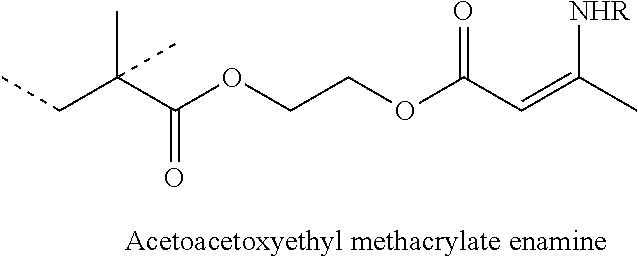Latex Particles Imbibed With a Thermoplastic Polymer
a thermoplastic polymer and latex technology, applied in the direction of polyester coatings, polyurea/polyurethane coatings, adhesives, etc., can solve the problems of inability to meet the requirements of aqueous dispersions, inability to bind to the surface of the polymer particles, etc., to achieve the effect of removing the limitation of building viscosity and reducing the limitation of building
- Summary
- Abstract
- Description
- Claims
- Application Information
AI Technical Summary
Benefits of technology
Problems solved by technology
Method used
Image
Examples
example 1
Preparation of Intermediate Latex Modified with a Thermoplastic PolyUrethane Polymer
[0094]Intermediate Latex 1 (375.0 g) was charged into a flask and diluted with deionized water (266.4 g). Surfactant C (2.8 g) was added to the latex with stirring over 15 min. The pH of the latex was adjusted to between 6.0 and 7.0 by slowly adding TEA (0.3 g). The diol (UD, 15.0 g) was added slowly and the latex was stirred for 30 min. The diisocyanate (IPDI, 39.8 g) was then added dropwise over 10 min, and then stirred for 10 additional min. The contents of the flask were heated to 85° C. and held for 3 h, after which time the flask was cooled to below 30° C. The pH of the final latex was adjusted to between 8.5 to 9.5 with TEA (1.3 g), passed through a 100-mesh screen and characterized for % solids, pH, particle size, Tg and MFFT (Table 3).
example 2
Preparation of Intermediate Latex Modified with a Thermoplastic PolyUrethane Polymer
[0095]Intermediate Latex 5 was charged into a flask (325.0 g) and diluted with deionized water (230.2 g). Surfactant C (2.4 g) was added to the latex with stirring over 15 min. The pH of the latex was adjusted to between 6.0 and 7.0 by slowly adding TEA (0.2 g). The diol (UD, 13.0 g) was added slowly and the latex was stirred for 1 h. The diisocyanate (IPDI, 20.0 g) was then added dropwise over 10 min, and the mixture was stirred for 30 min. The contents of the flask were heated to 85° C. and held for 3 h. After 3 h, the flask was cooled to below 30° C. The pH of the final latex was adjusted to 8.5 to 9.5 with TEA (1.6 g), passed through a 100-mesh screen and characterized for solids, pH, particle size, Tg and MFFT (Table 3).
examples 3-4
Preparation of Intermediate Latex Modified with a Thermoplastic PolyUrethane Polymer
[0096]Examples 3-4 were prepared using substantially the same procedure as detailed for Example 2, except that the reactor contents were stirred for 1 h after the addition of the diisocyanate. The % solids pH, particle size, Tg and MFFT are detailed in Table 3. Table 3 shows an increase in MFFT for Examples 1 and 3.
TABLE 3Latexes Modified with PolyUrethane using a 1:1 Molar Ratio Diisocyanateto DiolEx. 1Ex. 2Ex. 3Ex. 4Int. LatexInt. 1Int. 4Int. 1Int. 4Int. Latex (g)375.0325.0325.0375.5DI Water (g)266.4230.2230.8259.5Surfactant C (g)2.82.42.52.8TEA (g)0.30.20.30.2UD (g)15.013.0——T250 (g)——13.015.0IPDI (g)39.820.026.113.4TEA final (g)1.31.62.22.4% HEMA10% 0%10% 0%% diol reacted (g)56%47%46%40%Latex solids35%34 &35%32%Particle Size (nm)213218214213pH9.28.69.19.1Tg (° C.)35242317MFFT (° C.)38253327
PUM
 Login to View More
Login to View More Abstract
Description
Claims
Application Information
 Login to View More
Login to View More - R&D
- Intellectual Property
- Life Sciences
- Materials
- Tech Scout
- Unparalleled Data Quality
- Higher Quality Content
- 60% Fewer Hallucinations
Browse by: Latest US Patents, China's latest patents, Technical Efficacy Thesaurus, Application Domain, Technology Topic, Popular Technical Reports.
© 2025 PatSnap. All rights reserved.Legal|Privacy policy|Modern Slavery Act Transparency Statement|Sitemap|About US| Contact US: help@patsnap.com



